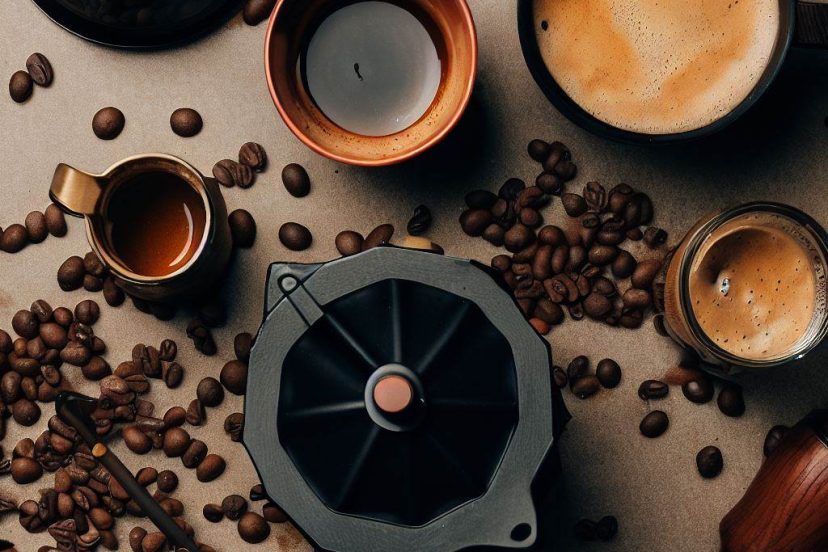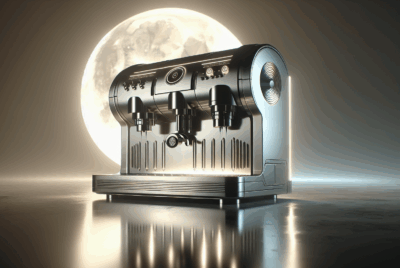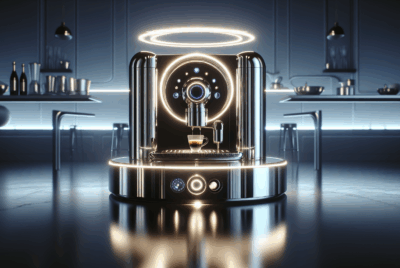How to Make Espresso Without a Machine: A Comprehensive Guide for Brewing Espresso at Home
As an Amazon Associate, I earn from qualifying purchases, at no additional cost to you. Disclaimer
Introduction
There’s nothing quite like the deep, robust flavor of a freshly made espresso, is there? But what if I told you that you don’t necessarily need an expensive espresso machine to make it at home? Yes, you heard that right! Let’s dive in and learn how to make espresso without a machine.
Understanding Espresso
What is Espresso?
Simply speaking, an espresso is a concentrated form of coffee, served in “shots”. Made by forcing hot, pressurized water through finely ground coffee beans, espresso forms the base for many well-loved coffee drinks, such as lattes and cappuccinos.
Why is Espresso Unique?
The difference lies in the brewing process. The high-pressure extraction process gives espresso its unique flavor, characterized by its strong taste and creamy consistency. So, the question is, how can we replicate this process without an espresso machine?
The Basics of Espresso Making
When it comes to espresso making, understanding the basics is just as crucial as having the right tools and ingredients. So let’s go over the main elements needed to craft your first home-brewed espresso.
Ingredients Needed
The heart of a fantastic espresso is no doubt in its main ingredient – coffee beans. But not just any coffee beans, mind you! Opt for freshly roasted beans and avoid pre-ground coffee. The quality of beans significantly impacts the taste of your espresso. If you’re not sure where to start, consider beans labeled as ‘espresso roast’ – they’re typically a safe bet.
And don’t forget about the water! It may seem trivial, but using clean, filtered water can make a noticeable difference in your espresso. Tap water often contains impurities and minerals that can alter the taste of your coffee.
Tools Required
Now, let’s talk about tools. The first and foremost tool you need is a good grinder. I remember the first time I tried to make espresso at home; I thought I could get away with using pre-ground coffee. Spoiler alert – it was a disaster! Pre-ground coffee is typically too coarse for espresso, and using it results in a weak, under-extracted espresso.
Invest in a burr grinder that gives you control over the grind size. A fine grind is what you need for a delicious, full-bodied espresso. Don’t skimp on this – a quality grinder can last for years and will make a massive difference to your espresso game.
You’ll also need a stovetop kettle or any reliable source of heating water. This could be an AeroPress, Moka Pot, or French Press. These tools might sound fancy, but they are pretty straightforward to use once you get the hang of it. We’ll delve into how to use each one in the next section.
Finally, a quick tip from my own experience: patience is key. Espresso-making is both a science and an art. You may not get it perfect on your first try, but with patience, practice, and a few sips of some delicious (and perhaps not-so-delicious) espressos, you’ll be well on your way to becoming a home-barista.
How to Make Espresso Without a Machine: A Step-by-Step Guide
Brewing espresso at home without a machine might is actually a fairly simple process. I’ll walk you through three methods that I’ve tried and tested, which have served me well over the years.
Method 1: The AeroPress Method
When I first started making espresso at home, the AeroPress quickly became my favorite method, and here’s why: it’s compact, portable, and incredibly easy to use.
Steps to Use the AeroPress
- Grind the coffee beans to a fine consistency. You’ll need about 20g (roughly 2 tablespoons). Remember, the grind consistency should be similar to table salt.
- Using a kettle or electric tea pot, heat your water to around 200 degrees Fahrenheit. If you don’t have a thermometer, bring the water to a boil and then let it cool off for a minute or two.
- Meanwhile, assemble your AeroPress. Place the filter in the drain cap, wet it slightly (this removes any paper taste), and then secure it onto your AeroPress.
- Place the AeroPress onto your cup and add the ground coffee.
- Pour the hot water into the AeroPress, filling it to the ‘4’ level. Stir the mixture gently for a few seconds.
- Insert the plunger and press down slowly. It should take about 20 to 30 seconds to fully depress the plunger. And there you have it – a bold, rich espresso!
Method 2: The Moka Pot Method
The Moka Pot is a classic espresso maker that can be found in many Italian households. I was gifted a Moka Pot a few years back and it has been an interesting journey understanding its nuances.
Steps to Use the Moka Pot
- Grind about 20-22g of coffee beans to a consistency slightly coarser than what you’d use for the AeroPress. Too fine a grind can lead to over-extraction, giving the espresso a bitter taste.
- Fill the lower chamber of the Moka pot with cold water up to the valve or line.
- Fill the Moka Pot’s funnel with the ground coffee, lightly tamping the surface with your fingers. Don’t pack it too tightly, or the water will struggle to pass through the coffee.
- Screw the top chamber onto the base, then place the Moka Pot on your stovetop. Heat on medium until the water in the lower chamber boils and pushes through the coffee into the upper chamber.
- Listen for a hissing, bubbling sound. Once the upper chamber is filled with coffee, remove the Moka Pot from heat. I like to run the base under cold water to stop the extraction process.
- Pour your espresso into your favorite cup and enjoy!
Method 3: The French Press Method
The French Press is a versatile brewing device that can be used for making more than just coffee – yes, you can make espresso with it, too!
Steps to Use the French Press
- For the French Press method, grind 2/3 cup of coffee beans to a coarse consistency, almost like breadcrumbs. Using a coarse grind prevents your espresso from turning out overly bitter.
- Place the ground coffee into your French press, then heat your water to around 200 degrees Fahrenheit.
- Pour enough hot water into the French press to just cover the grounds. Give the mixture a gentle stir, then let it sit for about 30 seconds. This process, known as blooming, helps to release the gases from the coffee, leading to a better extraction.
- Pour in the rest of the water, then place the lid on your French Press with the plunger pulled all the way up. Let the coffee steep for about 4 minutes.
- After 4 minutes, slowly press the plunger down. If it’s hard to press, that means your grind is too fine; if it’s too easy, your grind is too coarse.
- Pour your espresso into a cup immediately to prevent further extraction. Remember, the French Press method will produce a less concentrated espresso compared to the AeroPress and Moka Pot methods.
A few important tips: always use fresh coffee beans and clean water, measure the coffee and water accurately, and control the water temperature carefully.
Comparing Espresso Machine and Non-machine Methods
Before we dive into the comparison, let me share a little story. When I first started making espresso at home, I was dead set on getting an espresso machine. I mean, that’s how it’s made in coffee shops, right? But then I learned about these non-machine methods and decided to give them a try. I was pleasantly surprised by the results!
That being said, let’s dissect the key differences between using an espresso machine and the non-machine methods we discussed above.
Espresso Machine
An espresso machine uses high pressure to force hot water through finely ground coffee. This process extracts the oils, flavors, and pigments from the coffee, resulting in the strong, full-bodied shot of espresso we all love.
Espresso machines are often used in coffee shops because they are efficient and consistent. They have built-in mechanisms to control temperature and pressure, so the espresso shot is nearly perfect every time. However, espresso machines can be quite pricey and may require regular maintenance.
From a beginner’s perspective, an espresso machine can seem a bit intimidating due to its multiple features and settings. But, if you’re a regular espresso drinker, investing in a good machine might be worth it in the long run.
Non-machine Methods
On the other hand, non-machine methods like the AeroPress, Moka Pot, and French Press are more affordable and portable, making them excellent options for home use or travel. These methods give you more control over the brewing process, which can be a lot of fun and allows you to experiment with different variables to suit your taste.
When I make espresso using these methods, I find the process almost therapeutic. It’s a bit more hands-on, and there’s a sense of achievement when you get that perfect shot. Plus, the cleanup is a lot easier!
However, it’s worth mentioning that the non-machine methods might not produce a “true” espresso, strictly speaking, because they can’t generate the same amount of pressure as an espresso machine. The end result might lack the distinct “crema” you get from a machine-made espresso. However, you can still get a strong, flavorful coffee that is very similar to a traditional espresso.
Conclusion
Your choice between these two methods will depend on your budget, how much control you want over the brewing process, and how often you plan to make espresso. If you’re just starting out or don’t drink espresso very often, I’d recommend trying one of the non-machine methods first. If you find yourself falling in love with the process and the drink, then you might want to consider investing in an espresso machine. Remember, no matter which method you choose, avoid using stale coffee beans, boiling the water, or rushing the brewing process. These mistakes can negatively affect the taste of your espresso.
Frequently Asked Questions (FAQs)
1. Can I make espresso without an espresso machine?
Yes, as we discussed, you can use methods such as the AeroPress, Moka Pot, or French press.
2. How do I get the best taste out of my homemade espresso?
Ensure you use fresh coffee beans and clean, filtered water.
3. What grind size should I use for each method?
For AeroPress, use a fine grind. For the Moka Pot and French Press, use a coarse grind.
4. What is the ideal water temperature for brewing espresso?
Aim for a temperature of around 200 degrees Fahrenheit.
5. How do I clean my brewing equipment?
Rinse it with hot water after each use to prevent coffee oil buildup.




